Cars and motorcycles used to require what was called a “tune-up” every 1,000 miles. Spark plugs would be pulled, cleaned (every gas station had an air-driven spark plug cleaner), gapped, and re-installed. If any plug’s heavy gauge center wire was rounded by spark erosion, its tip might now be filed square. An abrasive strip was used to remove any roughness from the hard-metal contacts in the mechanical contact-breaker. After cleaning, the gap between the points was adjusted to spec, and timing was checked and reset as required, by use of a strobe light aimed at timing marks. The engine would be warmed up and its idle speed adjusted. A multi-carb bike engine would have its throttle slides synchronized before the idle adjustment. Engine oil would be drained (comes out quicker when the engine’s hot) and oil and filter replaced.
What if you didn’t have regular tune-ups? Plug gaps would grow until cylinders would misfire, and contact-breaker rubbing-block wear would close up the points gap until your engine would barely run.
All but the oil change is gone now, and oil changes occur at much longer intervals.
Why did spark plug gaps grow, requiring frequent re-setting? The ignition process was different four or more decades ago. The contact-breaker closed, sending battery voltage into the primary (heavier wire, fewer turns) winding of the ignition coil. As coil current flowed, a magnetic field was established, containing energy. When the distributor’s next cam lobe caused the contacts to open, coil primary current decayed and the magnetic field it had established began to collapse. As it did so, it induced a voltage in every turn of the secondary winding of the coil (many, many turns of much finer wire). Added together, this secondary voltage was thousands of volts (the output voltage was roughly battery voltage, multiplied times the ratio of coil primary turns to secondary turns).
As secondary voltage increased, it passed along the plug wire to create a rising electric field between the spark plug’s gap electrodes. Any free electrons in the gap would now be violently accelerated toward the ground electrode (The hot center wire is typically made negative because the hotter an object is, the more easily it can emit electrons) . These accelerated electrons hit molecules in their path, possibly ionizing them (knocking other electrons loose). In this way an “avalanche” of electrons is created as a chain reaction, and the plug gap is ionized, making it electrically conductive (in a lightning strike, we see the light emitted from the ionized conduction path. The bang of thunder is the explosive expansion of the intensely heated gas in that path).
The practice of squaring the end of the center-wire by filing was based on the fact that electric fields are more concentrated near sharp edges (same principle as a lightning rod). This is also the basis for the use of very fine iridium center-wires in modern plugs.
The first part of the spark discharge in a coil-and-battery system is the capacitive part, and consists of the energy stored in the electrical capacitance the plug wire. Because this discharges extremely fast, its current and its energy release are intense, but this phase lasts only microseconds. Once this has taken place, the voltage across the now-ionized gap falls to around 40 volts. Current continues to flow, but this part of the discharge uses energy stored in the inductance of the ignition coil’s secondary winding. This process is very like that in an electric welder with an arc-striking feature; a very high initial voltage is applied to break down and ionize the gap, after which welding current continues to flow across the gap at around 40 volts.
In an electric welder, that 40-volt discharge is what melts metal and (in the case of stick-welding) transfers it from rod to weldment. But in a spark plug, that discharge erodes metal from the center wire, causing its tip to become rounded and the plug gap to increase.
In modern ignition systems, use of resistor plug wires (carbon-core rather than metal conductor) or plugs with internal resistors allows only the capacitive part of the spark discharge to take place, after which the normal 40-volt inductive discharge is dissipated by resistance.
Forty years ago, the long inductive discharge increased the chance of avoiding misfire by the fact that there was an arc capable of causing ignition, persisting for as long as 1,000 microseconds (which is 36 crank degrees at 6000 rpm). Long duration arcs like this have been useful in engines with especially poor fuel-air mixing, such as AA Fuelers and two-strokes (in which a brief spark might pass through unmixed fuel or air, or even exhaust gas, resulting in a misfire). But for the daily vehicle user, the inductive part of the discharge had to go, because it produced gap erosion and the need for frequent plug re-gapping. To give the remaining very brief spark a greater chance of passing through a bit of ideally ignitable mixture, the plug gap has been made much larger—on the order of 0.060 inch.
In aviation piston engines of the 1940s and 1950s—flying long missions of 15 or more hours with magneto ignitions that were doing well to jump a 0.018-in. plug gap—gap erosion became a life-and-death matter. Therefore, a metal with a very high melting-point—platinum melts at 3,191 degrees Fahrenheit—was used as the plug electrode tip, as a means of slowing the erosion process. Legend has it that some smart operator in 1946 bid on thousands of brand-new aircraft-engine spark plugs and set teenagers to work with diagonal cutting pliers, pinching off the platinum and discarding the plug. Today’s high melting point gap material is iridium (melting point of 4,417 degrees Fahrenheit), generally in the form of a fine wire. This, like the sharp edge of a hand-filed old-time center wire, concentrates the electric field caused by rising coil voltage, allowing easier, lower-voltage breakdown of the plug gap. Because the fine wire’s tip radius is very small even if eroded to a hemisphere, it concentrates the electric field nicely.
Because there is no longer any erosive inductive discharge crossing the plug gap, plugs last for tens of thousands of miles without attention (indeed, they become notoriously “baked-in” to certain engines, requiring extraordinary measures to extract them).
To simplify installation and prevent radio interference, coils are now often made in “stick” form as part of the plug cap. This, by eliminating the plug wire, eliminated the “antenna” that radiated the interference in the first place.
Back in the days of coil-and-battery ignitions with mechanical contact-breakers, there was also a danger of erosive arcs occurring as the contact points were pushed open by the distributor’s cam. To prevent this, a capacitor was wired across the contacts. As the contacts opened, the current flow that had established itself across them simply flowed into the capacitor (we called it a “condenser” in that application) rather than forcing a destructive arc across the opening contacts. Some minor arcing did take place, which was why we had to sometimes smooth the contacts with a points-file or thin abrasive stick.
Today, ignition sparks are triggered by non-contact means such as magnetic, radio frequency, or Hall-effect triggers, so the crude cam-operated mechanical switches we called “points” or contact breakers are long gone. Timing, once set, requires no attention.
I can’t say I miss the 1,000-mile tune-up.











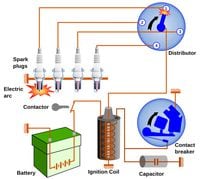

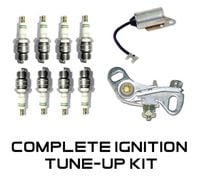

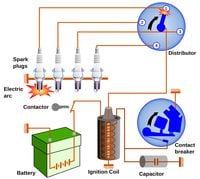
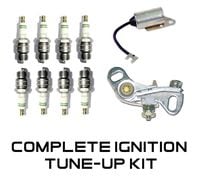
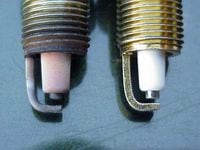
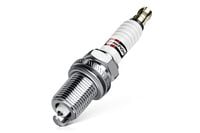
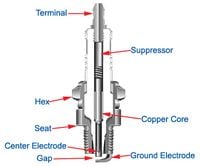


/cloudfront-us-east-1.images.arcpublishing.com/octane/QSS5DZ6SKJEU3AKE4KDAWYBEFY.jpg)
/cloudfront-us-east-1.images.arcpublishing.com/octane/SMCEQCLWRVEFTJJES6TAHB3OOQ.jpg)
/cloudfront-us-east-1.images.arcpublishing.com/octane/JCACIDCAC5FUNPTXO2BOUHGGII.jpg)
/cloudfront-us-east-1.images.arcpublishing.com/octane/DC7ZGILA2BCJXHZIUNYGV7JSEA.jpg)
/cloudfront-us-east-1.images.arcpublishing.com/octane/EWJEZUGWEZGABDEQWB64WL46GQ.jpg)
/cloudfront-us-east-1.images.arcpublishing.com/octane/5NHBMRMSFVD5JAPFNMBMNPGXQE.jpg)
/cloudfront-us-east-1.images.arcpublishing.com/octane/WHE43SCPLJBRNANAJAGXHOAIEU.jpg)
/cloudfront-us-east-1.images.arcpublishing.com/octane/6R56AQAW6NDE7BBIJ3SMCOOY5A.jpg)
/cloudfront-us-east-1.images.arcpublishing.com/octane/JMQTUE2FKZFURJTJXDMM4V47AQ.jpg)
/cloudfront-us-east-1.images.arcpublishing.com/octane/P2QYJDMQNVEANMQFXHNB3OVFKQ.jpg)
/cloudfront-us-east-1.images.arcpublishing.com/octane/VNKGXM4AA5BPRGERJOPV6GADAQ.jpg)
/cloudfront-us-east-1.images.arcpublishing.com/octane/2WS4YIFLTNG25L25WP7ZFLSWJM.jpg)
/cloudfront-us-east-1.images.arcpublishing.com/octane/UXRS6ZVQZFC23FY2EDYNT5WMVA.jpg)
/cloudfront-us-east-1.images.arcpublishing.com/octane/7JETMCKNVRGDZIGB3JCITGLPUU.jpg)
/cloudfront-us-east-1.images.arcpublishing.com/octane/OZV6E2KNIJDVHGOKXQQ2AHKLHQ.jpg)
/cloudfront-us-east-1.images.arcpublishing.com/octane/XSKMIBFZIZDN7JC6P7SMNMD3QA.jpg)
/cloudfront-us-east-1.images.arcpublishing.com/octane/ITVHWHVQ75BQBHACERYDJLPLHE.jpg)
/cloudfront-us-east-1.images.arcpublishing.com/octane/M3QRBSQ4VFEVPKYTTM3OETVFBU.jpg)
/cloudfront-us-east-1.images.arcpublishing.com/octane/H3EMT5NJ5BDZPBBH27SW3ADQH4.jpg)
/cloudfront-us-east-1.images.arcpublishing.com/octane/XTROSHDZFJB5DIJYU2VF2REFIU.jpg)
/cloudfront-us-east-1.images.arcpublishing.com/octane/7EUSM4GQEBEFTPAYZ6MOMKMMUQ.jpg)
/cloudfront-us-east-1.images.arcpublishing.com/octane/ZN44KZLHD5CHVIY3WZYAGTPGSI.jpg)
/cloudfront-us-east-1.images.arcpublishing.com/octane/5A776WXBY5GAPDYFTTUEUZNIJA.jpg)
/cloudfront-us-east-1.images.arcpublishing.com/octane/NCYHFQ2S3BAT7EC7VDN2ONGRTU.jpg)